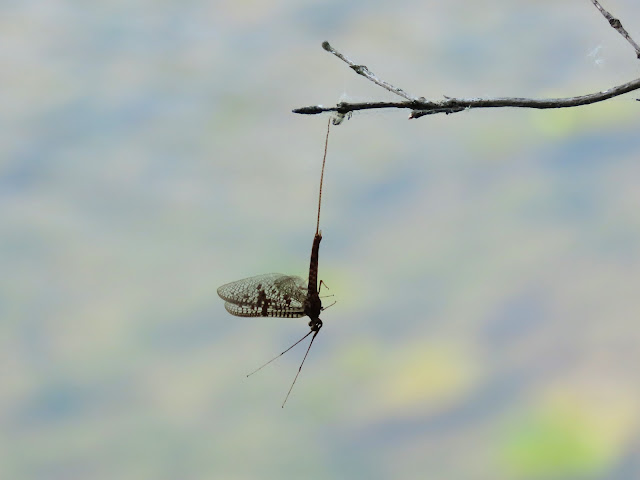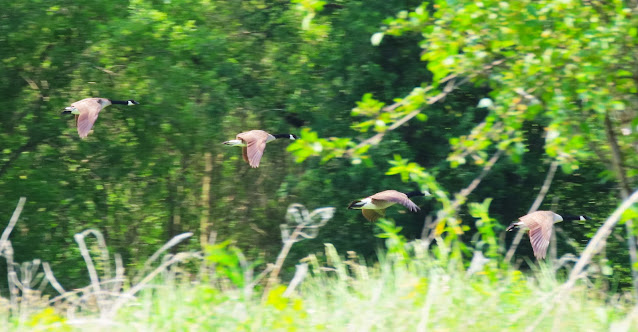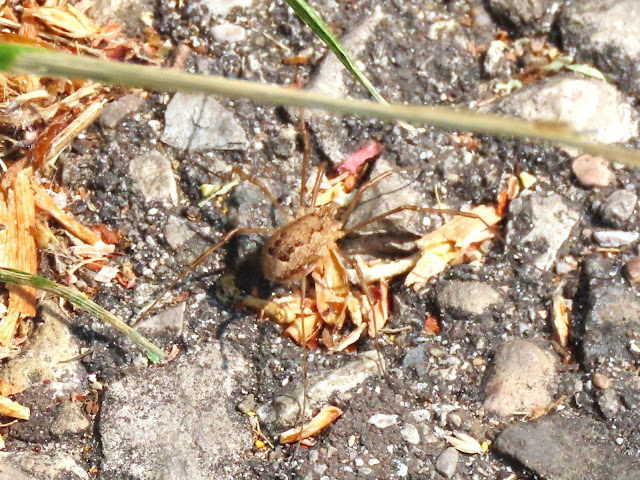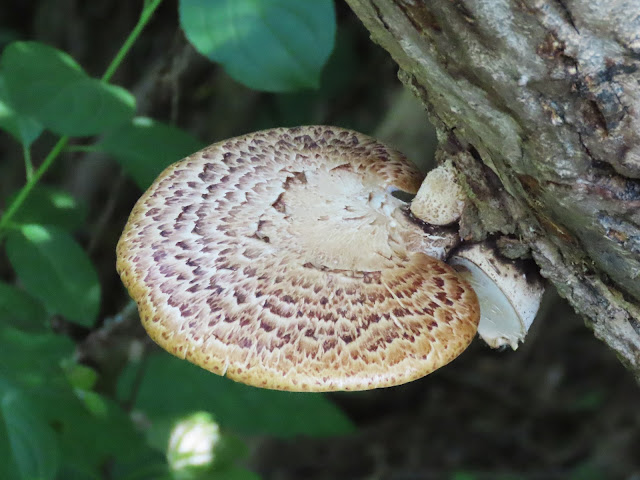The earth I tread on is not a dead inert mass. It is a body, has a spirit, is organic, and fluid to the influence of its spirit, and to whatever particle of that spirit is in me.
Henry David Thoreau
04 June, 2023
The Mill Race Trail, St. Jacobs, ON
Dame's Rocket (Hesperis matronalis) was at its showy best - invasive, yet beautiful.
River Jewelwings (Calopteryx aequabilis) are found along our local waterways from early June through the end of August, and we observed several, all females (note the white pseudostigma).
It was a hot day and it is hard not to believe this male Northern Cardinal (Cardinalis cardinalis) was cooling off.
If an Eastern Chipmunk (Tamias striatus) feels the heat, it simply seeks the cool seclusion of its underground den.
This appears to be a Mayfly (Order Ephemeroptera) somehow caught up on a branch and unable to free itself.
The water was occupied by hundreds, if not thousands of small fish. While having little expertise with fish, I believe this is a Striped Shiner (Luxilus chrysocephalus), and it appeared to be the predominant species.
Last year while visiting Grand Manan Island, NB, I was able to pick up several free books, including Fishes of the World (1975), and it was great fun to search through this work to try to identify the species and learn more of its lifestyle. There is nothing quite as comforting to a naturalist as the slightly musty smell of an old book. Accompanied by a glass of wine it is an ecstatic journey of sensuous pleasure!
Yellow Iris (Iris pseudacorus) is simply gorgeous.
White-striped Black (Trichodezia albovittata) is a very appealing little diurnal moth.
The processes of nature are eternal and these Elms (genus Ulmus) growing out of a beaver-chewed stump illustrate the point that in the wake of destruction, natural or anthropogenic, renewal always ensues.
06 June, 2023
RIM Park, Waterloo, ON
We had barely set foot on the trail when we observed a beautifully marked caterpillar of Confused Haploa Moth (Haploa confusa). I am inclined to think that this is our first sighting ever of the larva of this species.
Summer really is the season for Odonata but taking pictures of these flighty creatures is not always easy. Sometimes they will obligingly alight within photographic distance, unimpeded by vegetation or other obstacles, as happened with this female Violet Dancer (Argia fumipennis violacea).
Recently I saw a promotion for a company that will create a family crest for you. This is all seems pretentious in the extreme, but if ever I were to do it, Canada Goose (Branta canadensis) would feature prominently.
A Phalangid Harvestman (family Phalangidae) is not always easy to identify down to the species level, and so it is with this fine specimen.
07 June, 2023
The Mill Race, St. Jacobs, ON
Miriam has friends from high school who regularly go out together, often for lunch, and I was invited to accompany Miriam, Trish and Lynn on a walk along the Mill Race followed by lunch in St. Jacobs.
It was a lovely day, warm and sunny, and I enjoyed myself thoroughly in the company of three charming ladies.
A Muskrat (Ondatra zibethicus) was preparing its lunch too - without three companions, however.
Having researched this insect for almost an hour, I am quite sure that is is found in the genus Phanogompus. I have also loaded it onto the internet site iNaturalist, but identification beyond the genus has not so far been confirmed.
Three species are possible in this area: Lancet Clubtail (P. exilis), Ashy Clubtail (P. lividus) and Dusky Clubtail (P. spicatus).
I am unable to offer any further clarification, but it was an exciting find. Perhaps the picture does not have quite enough detail to permit differentiation between these three very similar species.
For those of you who might be interested, here are the books I used to attempt specific identification.
Dragonflies through Binoculars, Sidney W. Dunkle (2000), Oxford University Press
The Dragonflies and Damselflies of Algonquin Provincial Park and Surrounding Area, Colin D. Jones, Andrea Kingsley, Peter Burke and Matt Holder (2013), The Friends of Algonquin Park
Dragonflies and Damselflies of the East, Dennis Paulson (2011), Princeton University Press
Dragonflies and Damselflies, A Natural History, Dennis Paulson (2019), Princeton University Press
Dryad's Saddle (Cerioporus squamosus) is a very common bracket fungus.
When we saw this Baltimore Oriole (Icterus galbula) resting uncharacteristically on the ground we thought it might be injured, but when we approached a little too close for its liking it took off and appeared to be in good health.
A female Violet Dancer (Argia fumipennis violacea) joined the parade of odenates joining us on our walk.
Eastern Grey Squirrels (Sciurus carolinensis) were seldom far from view, knowing that humans sometimes provide food.
Several gorgeous male River Jewelwings flitted along the stream banks, seemingly not reluctant to pose for a picture now and then.
We always delight in seeing American Toad (Anaxyrus americanus) and this individual was a large, robust specimen.
Grasshoppers are not always easy to identify and all I can say with certainty about the following individual, is that it is a type of Band-winged Grasshopper (subfamily Oedipodinae).























































What a wonderful post you have presented us with, David. There's something for everyone featured in it and, for me, it was perfect. Although the botanical side of things was a bit outside my fields of interest, even the beautiful flower shots provided a colourful interlude between other subjects that were particularly interesting to me.
ReplyDeleteMy very best wishes to you and Miriam - - - Richard
Thank you and Miriam so very much.
ReplyDeleteBeautiful post, David. I love to see all the flowers, the birds, the animals and the insects. We live in a wonderful but fragile world. Hugs and kisses, Marit
ReplyDeleteSadly, we are failing to protect its fragility, Marit. Hugs and kisses - David
Delete...very little was missed by your eye. In my book dane's rocket is one of the nicest invasive plants. Happy Canada Day.
ReplyDeleteIt is quite lovely, isn't it?
DeleteHi David.
ReplyDeleteYou have so much beauty to show and let us enjoy this wonder of nature.
Super David.
Greetings from Patricia.
I hope that you have helped that poor Mayfly to free itself after taking the picture :-) I love wild flowers, but there are so many that I can't properly name them. Baltimore Oriole looks so gorgeous!
ReplyDeleteThere was nothing I could do, Angie. It was high in a tree on the opposite bank of the Mill Race.
DeleteGoodness there is a lot to see on your walks. I must admit I wouldn't notice a lot of the insects. I do enjoy the birds and the flowers are lovely!
ReplyDeleteas I read through the info and looked at all the gorgeous photos, I thought of how patient you have to be to look through the books to identify all these amazing creatures of our earth. I thought i don't have that much patience and then I thoought, i do have it, but my interest is in the creative side of software, i can and do spend hours learning how and what. you will not like my post today, all fantasy that took hours. favorite today is toad, I love ugly toads and your squirrlel looks a lot like ours. yesterday i through a large chunk of frozen watermelon in the front yard and laughed my head off at the squirrel hugging it while he filled his mouth with frozen watermelon. no pics, it was through the window glass
ReplyDeleteOOPS! I want to change the toad to second place and make the cardinal my favorite. that is adorable and a really smart bird
ReplyDeleteMaravilloso reportaje, para mí maravilloso. Abrazos para Miriam y para ti.
ReplyDeleteYou are amazing. Sharing the beauty we live in.
ReplyDeleteThanks for sharing these wonderful pictures.
ReplyDeleteY tanto que es amocionante descubrir la naturaleza. Es una maravilla como lo demuestras en este post. Flores y aves conviviendo en su entorno natural y en armonía David. Las flores si son comunes por aquí, no así las aves que vamos conociendo por ti. Gracias.
ReplyDeleteOs deseo un buen fin de semana.
Un abrazo.
Each photo is a feast! So much to observe! Wonderful post!
ReplyDeleteLoved all the photos...except for the spider. I think I am pretty much afraid of spiders. I'm scrolling along, come to the spider, and I physically react--an involuntarily shudder. As beautiful as they are and needed in this world...I am not a fan, I guess. But it has never stopped me from enjoying your wondrous posts. ;)
ReplyDeleteHi David, it's nice to tag along on your walks. So many insects, birds and wild flowers. But my fave today is the toad, what a fantastic specimen. I've never seen one like that before. Happy Canada Day, hugs, Valerie xxxxx
ReplyDeleteBuenas tardes, estimado amigo, qué bellos reportajes y qué sabia es la naturaleza, como de un tocón brota de nuevo la vida. Es una pena que algunas plantas, aun siendo bellas en su floración, invadan terrenos que no les pertenece y siempre por la causa del ser humano, una vez arraigadas es casi imposible por no decir imposible el eliminarlas.
ReplyDeleteLa primavera en toda su magnitud y belleza es muy difícil de superar.
Espero que los incendios devastadores que asolan Canadá hayan podido ser controlados y erradicados. Nos espera un verano muy complicado con estas elevadas temperaturas.
Un gran abrazo amigo y compadre profesor con toda mi admiración y respeto. Os deseo un feliz verano y mes de julio, abrazos para Miriam.
Buenas plantas con sus flores has recogido con tu cámara en tu caminar. También las especies animales merecen una mención especial.
ReplyDeleteUn abrazo
So much beauty seen through your eyes. Thanks for sharing, David.
ReplyDeleteHello David,
ReplyDeleteWonderful post and beautiful photos. You have been on some great outings. Some of my favorites are the GB Heron, the Oriole and the Toad and the Northern Crescent butterfly. Thank you for linking up and sharing your post. Take care, have a great weekend. PS, thank you for leaving me a comment.
You saw a variety of neat things. I love the dark squirrel and the Northern Crescent. I couldn't reach your blog with the link on critters but I have you in my side bar under favs! Enjoy your weekend!!
ReplyDeleteGreat post! After I had seen your two pictures of the Eastern grey squirrel and the American toad, I got other information about such marvelous creatures.
ReplyDeleteThe Baltimore Oriole is a colourful bird. Thank you for sharing!
Thank you for this wonderful post. I did enjoy seeing all of your photographs.
ReplyDeleteHappy Canada Day.
All the best Jan
That opening pink invasive bloom can invade my world all it wants. It's lovely. So, too, the iris and all these fabulous birds -- even your own Harry!
ReplyDeleteGreat photos. I feel sorry for the mayfly.
ReplyDeleteAll things beautiful. Of course the best is the Cardinal.
ReplyDeleteWhat a wonderful series of photos David.
ReplyDeleteVery nice that the male northern cardinal in the water to cool off and drink.
The squirrel is also nice, this species occurs in the Netherlands but is rare, we have the red squirrel here.
The yellow iris and the comfrey are also beautiful.
Fortunately, the Baltimore Oriole was not sick, this is also a beautiful species.
Greetings Irma
Beautiful pictures ! Nature is so diverse and colorful !
ReplyDeleteHave a nice week !
Anna
It's a great tour through that natural environment, which encompasses the interaction of many living species. I have never seen an American toad. I also like that black and orange bird (Baltimore oriole). Thank you for sharing marvelous pictures of all those creatures.
ReplyDeleteHave a nice Sunday!
Such an interesing blog post! I always find delight checking which species you get in your area, and it surprises me that we get some of them too here in Spain. Most of the species we share have been introduced from Europe into North America and have become invasive :(
ReplyDeleteThat squirrel is really dark, is it melanistic?
Have a nice Sunday.
Guillermo
In the northern part of their range there is a black form, presumably an adaptation to cold winters.
DeleteWhat a grand diversity. Perhaps half a dozen were familiar to me. I hope July is as generous to you.
ReplyDeleteThe flora and fauna has reached its peak.
ReplyDeleteSo beautiful... the nature out there now... thank you so much for your wonderful photos, I enjoyed every single one.
ReplyDeleteAnd yes, I can only agree with you, an old well-read book in hand and a glass of wine with it... it's right... thanks.
Many greetings to you and Miriam.
Come on over and we'll share a glass of wine together, Viola.
DeleteLa faune et la flore sont bien représentés avec vos photos. Les écureuils sont si mignons mais j'aime autant les insectes et oiseaux. Bonne soirée
ReplyDeletewell, this was a nice surprise, not that your bird posts aren't always welcome, but all the flowers and other creatures you encounter.
ReplyDeleteWhat a wonderful series of photos from your June outings (to be continued as you noted). I liked the variety of blooms, insects, birds and others. You and Miriam have such an appreciation and enjoyment of the natural beauty all around even to the smallest details and I am very appreciative, David.
ReplyDeleteThank you, Dorothy. You are very kind.
DeleteCute, interesting and beautiful flowers and critters. Hope nature will be preserved and not be destroyed by development.
ReplyDeleteBeautiful pictures!!...So sad to see that Mayfly...I hope someone could help this lovely creature!........Abrazotes, Marcela
ReplyDeleteHi David - what an interesting set of photos and information. A delightful read - thank you ... cheers Hilary
ReplyDeleteThank you for these extraordinary photos.
ReplyDeleteEverything so beautiful, from the flowers, insects and birds.
I really enjoyed this post such a wide selection of interests. The oriole is quite beautiful and the chipmunk is very cute. Not a single photo here though that does not deserve a comment....... Bisous Diane
ReplyDeleteThanks for sharing all your lovely flowers, insects (yes, they can be lovely) and critters..Our Chipmunks often skitter up the downspouts when Mollie is around..It's not unusual for her nose to be pushed up the end of one..Have a wonderful 4th..
ReplyDeleteWow you have captured so many wonderful critters.
ReplyDeleteWow~ Wonderful nature photos in June ~ all very professional looking ~ My amazement was the male cardinal in the water ~ I have never seen a cardinal do so ~ thank you ~
ReplyDeleteWishing you good health, laughter and love in your days,
A ShutterBug Explores,
aka (A Creative Harbor)
A great post to remind us how wonderful nature is and how we must respect it.
ReplyDeleteHi David,
ReplyDeleteNature clearly doesn't disappoint you. What a variety in flowers, birds, caterpillars, animals en insects. It must be a pleasure to have such an environment nearby. To go for a walk and being sure that you are going to enjoy it is what everybody is looking for.
Greetings, Kees
Love all you have captured here, particularly the wild flowers. I could almost smell that anemone
ReplyDeleteXO
WWW
You have had a beautiful outing with Miriam. I love the squirrels and the rose breasted rossbak. I think I like Canada too but I don't like the plane. Have a nice day.
ReplyDeleteI have a great fondness for herons.
ReplyDeletehere's a very diverse post David, for me the top is the oriole.
ReplyDeleteBut each animal or floral species was a delight.
Kisses (the fires are gigantic again this year where you live, we had smoke in France a few days ago. The sky was milky. I think of all the life that perishes and I'm so sad).
The Baltimore Oriole is my favorite. Very colorful bird I never see here.
ReplyDeleteWhat a fabulous and informative post! I thoroughly enjoyed seeing the beautiful sights. Thank you!
ReplyDeleteDavid, thank you for this post full of nature's beauty. It is lovely to see the trails with you, and I'm glad that you don't just pass by all these small wonders. I have noticed an abundance of salsify this year, not only in my garden but out on the trails as well. It can become quite invasive because of its easily flying around seeds, but boy are those seedheads beautiful. My true favorite in this post is the Northern Cardinal. They are such sweet birds and I wish we had them here.
ReplyDeleteYou will just have to come to Ontario to see them, Carola. I made creamed salmon for lunch yesterday and thought of you.
DeleteCreamed salmon sounds excellent, David. I'm on my way!
DeletePrachtige serie.
ReplyDeleteMooi om de bloemen en insecten / vogels te zien.
Groetjes Tinie
Hi David,
ReplyDeleteWOW, enriching walks full of wonderful finds, all beautifully captured!
Thank you fot sharing.
Regards, Maria